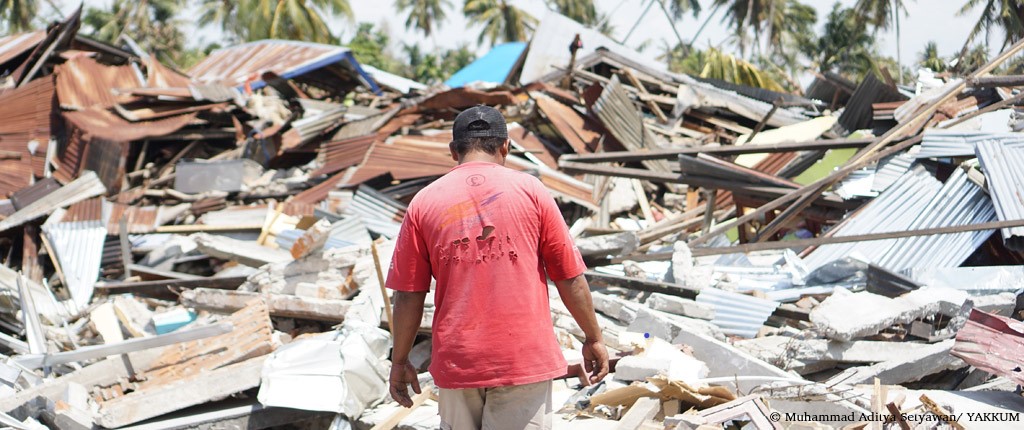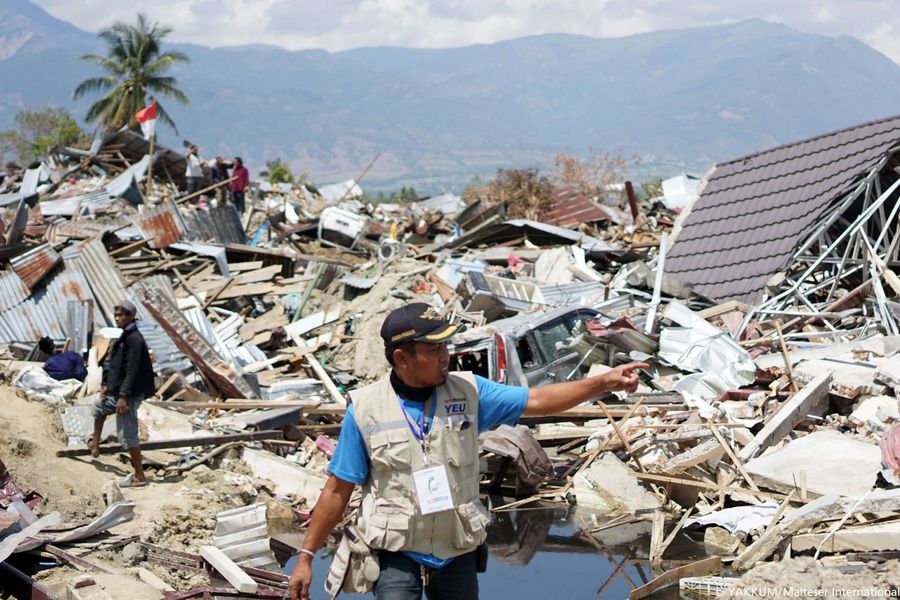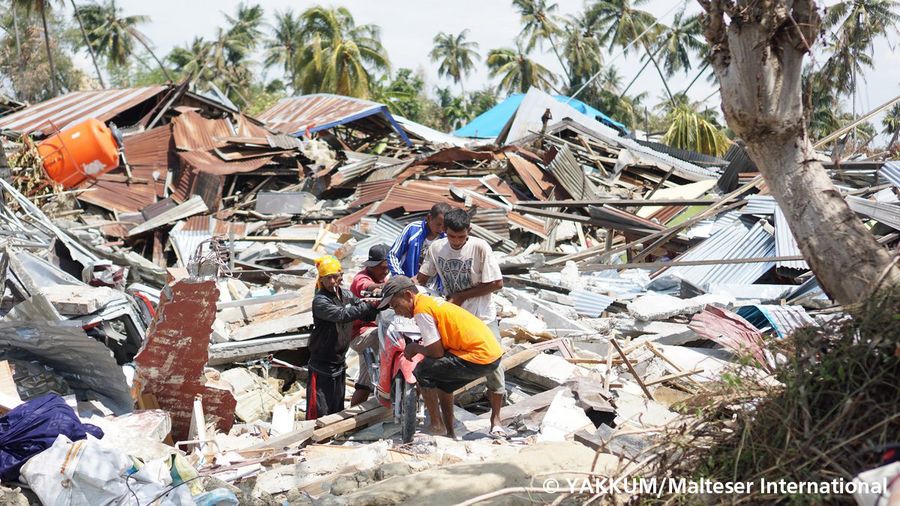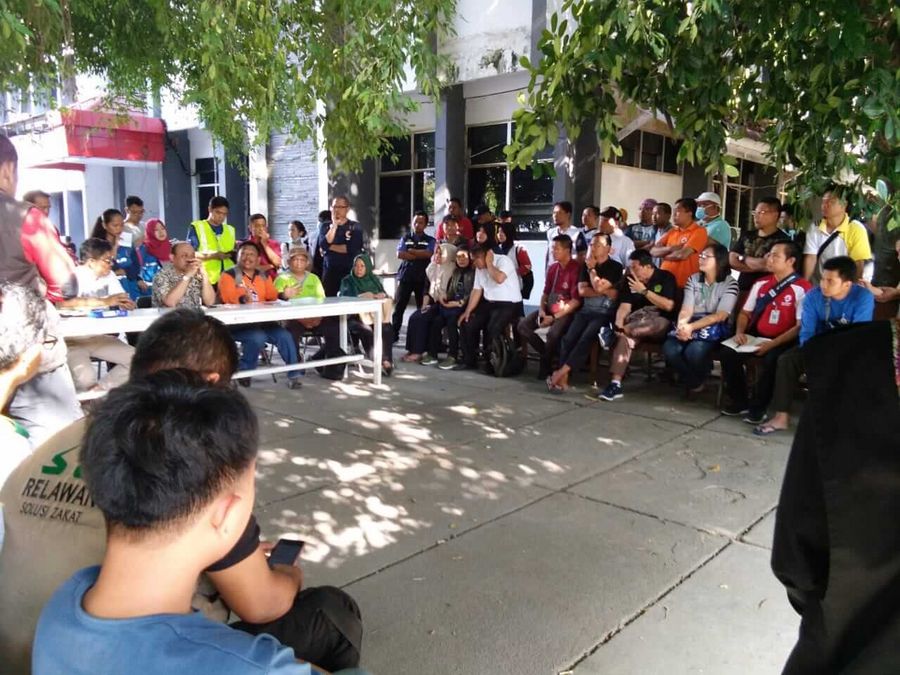Disaster risk reduction
Preparedness can save lives: We identify risks and prepare people for natural disasters.
Learn more
Tsunamis are huge waves, usually triggered by an earthquake on the ocean floor, and are considered one of the deadliest natural disasters of recent decades. They can bring devastating effects to affected coasts and can pose a great danger to people in risk areas. Strong tsunamis have the power to sweep away everything on land and near the coast - even cargo ships or entire buildings. In the past, there were giant waves that claimed many lives and left a trail of destruction in their wake.
Whether in 2004 in the coastal region of the Indian Ocean or in 2011 in Japan, the tsunami catastrophes hit these populations with full force. The 2004 tsunami, the deadliest of its kind, claimed the lives of more than 220,000 people. The floods in Japan claimed 16,000 lives. The 2011 tsunami also triggered the Fukushima nuclear disaster. Fortunately, disaster preparedness in risk areas has improved enormously since then.
Giant waves cannot be controlled. It is therefore all the more important to learn from previous disasters and to develop protective measures in the form of early warning systems. Malteser International is also committed to immediate relief measures and the reconstruction of affected areas.

A tsunami consists of a series of waves caused by an external event, such as an undersea earthquake. If the ground below sea level rises or falls suddenly, large waves are generated above the epicenter of the earthquake and spread in all directions at a high speed. While tsunamis have devastating effects on land, they are hardly noticeable on the open sea.
This treacherous characteristic of a tsunami coined its name: The term tsunami is Japanese and translates to "harbor wave." When Japanese fishermen returned to their home port after a calm day on the high seas and found it completely devastated, they could only explain the disaster by the fact that the giant wave first originated in the port.
In the open sea, the wave crests usually only reach a maximum height of 80 centimeters and therefore do not pose a danger even for small boats. However, when a tsunami hits low coastal water, the water masses pile up higher and higher. The resulting wave brings with it enormous destructive power, and even smaller waves can reach several kilometers inland. There, the water sweeps away trees, cars and houses. In most cases, it is not just one wave. Instead, several waves often follow one another. Tsunamis are therefore among the most devastating natural disasters.
A tsunami occurs when huge amounts of water are suddenly displaced in open water. This is caused by earthquakes, landslides, volcanic eruptions or meteorite impacts. By far the most frequent catalyst for tsunamis are underwater earthquakes, known as seaquakes. Tectonic plates shift and set large amounts of water in motion, resulting in the formation of giant waves. These increase in height the shallower the water becomes. Near the coast, the waves usually pile up several meters high.
But not every earthquake under water triggers a tsunami - strictly speaking, only 10 to 20 percent of all seaquakes result in a giant wave. Only when the seaquake reaches a magnitude of 7.0 on the Richter scale and the earth's tectonic plates shift vertically are the forces sufficient to generate a destructive flood wave.
A less frequent trigger for tsunamis are volcanic eruptions. These can eject enormous amounts of rock and ash into the sea, creating a pressure wave that can trigger a tsunami. One such example is the eruption of the stratovolcano on Knight Island (Papua New Guinea) in 1888. The natural event was followed by a tsunami that devastated neighboring islands.
While ordinary waves travel at a maximum of 90 km/h, tsunamis can reach speeds of up to 800 km/h - equivalent to the speed of an airplane. Due to the high speed, tsunamis cross entire oceans in just a few hours. The deeper the water, the faster the waves. In shallow waters, the speed of the tsunami is therefore usually reduced to between 30 and 50 km/h.
The waves of the tsunami spread out in a circle in all directions from their origin. On deep, open seas, they are comparatively small and, at 30 to 80 centimeters high, largely harmless. Near the coast, however, the waves pile up and in extreme cases reach heights of more than 30 to 50 meters.

Tsunamis pose a threat to coastal areas in many parts of the world. In theory, they can occur in all oceans and marine areas. However, regions such as the Pacific Ocean, where tectonic plates are adjacent to each other, are particularly at risk. At the northern edge of the Pacific Plate is the Pacific Ring of Fire. This is one of the most tectonically active areas on earth. Due to the high occurrence of earthquakes, the vast majority of tsunamis occur there.
However, there is also a tsunami hazard in other areas with significantly less activity at the plate margins, such as the Indian Ocean, the Mediterranean Sea or the Atlantic Ocean. Due to their geographical location, coastal countries in these areas are particularly affected. These include Japan, Indonesia and Thailand.

The images of previous tsunami disasters paint a picture of total destruction: harbors, villages and towns near the coast are swept away. What remains is a debris field of uprooted trees, collapsed buildings and destroyed infrastructure. The affected areas are usually covered in mud, sand and garbage. This usually renders fields and other agricultural land completely unusable. Salt and sand from the sea can also bring water supplies from wells to a standstill. In addition to the immediate destruction in coastal areas, tsunamis can claim countless lives. Moreover, many people in the affected areas lose their homes and livelihoods.
Electricity, gas and telephone lines are destroyed. Railways, roads, bridges and harbors simply no longer exist, so that entire regions are cut off from the outside world. This also jeopardizes the supply of food, drinking water and medicines. Long-term economic, social and ecological effects only become apparent in the period after the disaster. Reconstruction after such a devastating tsunami can take years and requires considerable resources and support from outside.
Nevertheless, devastating tsunamis like the calamity in Southeast Asia in 2004 are a rare exception. Only about 10 percent of all giant waves cause such damage or result in fatalities.
The following table shows an overview of the most severe tsunamis since 1923, sorted by the number of fatalities. The data illustrate that even comparatively low waves can cause great damage. The most recent tsunamis to date occurred in 2018 on the Indonesian islands of Java and Sumatra and in 2022 as a result of an eruption of the Hunga Tonga-Hunga Haʻapai underwater volcano. However, both are not among the most devastating giant waves.
| Day of the event | Country | Magnitude of earthquake | Maximum wave height in meters | Number of fatalities |
| 26.12.2004 | Southeast Asia | 9.1 | 50.90 | 227,899 |
| 11.03.2011 | Japan | 9.0 | 38.90 | 15,890 |
| 16.08.1976 | Philippines | 8.1 | 8.50 | 4,376 |
| 27.11.1945 | Pakistan | 8.0 | 15.24 | 4,000 |
| 04.11.1952 | Russia | 9.0 | 18.00 | 4,000 |
| 02.03.1933 | Japan | 8.4 | 29.00 | 3,022 |
| 22.05.1960 | Chile | 9.5 | 25.00 | 2,234 |
| 17.07.1998 | Papua New Guinea | 7.0 | 15.03 | 2,205 |
| 01.09.1923 | Japan | 7.9 | 13.00 | 2,144 |
| 04.08.1946 | Dominican Republic | 7.8 | 5.00 | 1,790 |

Disaster risk reduction has made great progress since the devastating tsunami in 2004: early warning systems have been set up, enabling people in risk areas to be warned in good time. This is intended to prevent future tsunami disasters. The early warning systems use modern measuring methods:
The warning systems can therefore predict tsunamis even before they hit the coast. This enables local authorities to initiate evacuation measures in good time to protect as many lives as possible.
The German Indonesian Tsunami Early Warning System (GITEWS for short) was set up in 2008 in response to the tsunami disaster of 2004, for instance. The German Research Center for Geosciences played a major role in the development of this early warning system. The system is one of the most modern in the world and is able to send a warning signal within a maximum of five minutes after a seaquake on the basis of approx. 300 measuring stations.
However, tsunamis are not preventable by the early warning systems. It is therefore all the more important that people know the natural warning signals of a giant wave. These are possible signs of a tsunami:
With these signs, warnings from local authorities should be followed closely. In the event of a tsunami warning, people should leave coastal areas immediately and seek higher ground, such as high mountains, roofs on stable high-rise buildings, or areas higher inland. Even after the first giant wave has passed, people should remain alert, as tsunamis usually consist of multiple waves.
Malteser International is committed to disaster risk reduction in vulnerable regions through a variety of measures. Our aim is to strengthen the resilience of local communities, for example by conducting awareness campaigns and trainings, developing emergency plans and procuring emergency reserves. By preparing protective as well as evacuation measures, ensuring adequate infrastructure, and strengthening local disaster preparedness and health services, lives can be saved in the event of a tsunami.
When tsunamis destroy entire coasts, fast and efficient aid is crucial. Malteser International supports affected areas that face numerous challenges after such a natural disaster. Expert teams or emergency medical teams (EMTs), consisting of doctors, paramedics and experts in drinking water and hygiene, can be quickly dispatched in the event of a crisis, such as in October 2018 after a tsunami in Indonesia. We also provided emergency aid and reconstruction support in tsunami-affected communities from 2005 to 2008.
The focus of our tsunami aid was, among other things, on basic medical care, the reconstruction of schools, houses and other infrastructure, and the establishment of income-generating measures. Clean drinking water and hygienic sanitation facilities are essential to prevent the spread of disease after the tsunami. Therefore, we also worked in affected areas to repair damaged water supply systems.
In addition to physical health, the mental health of those affected is also of great importance. Malteser International therefore focuses on psychosocial support in the aftermath of tsunamis, for example in the form of counseling programs. In this way, people receive professional help to cope with their traumas. Our work is generally aimed at helping affected communities on their way to reconstruction.
Preparedness can save lives: We identify risks and prepare people for natural disasters.
Learn moreDuring crises such as natural disasters or armed conflicts, we provide fast and effective emergency aid.
Learn more